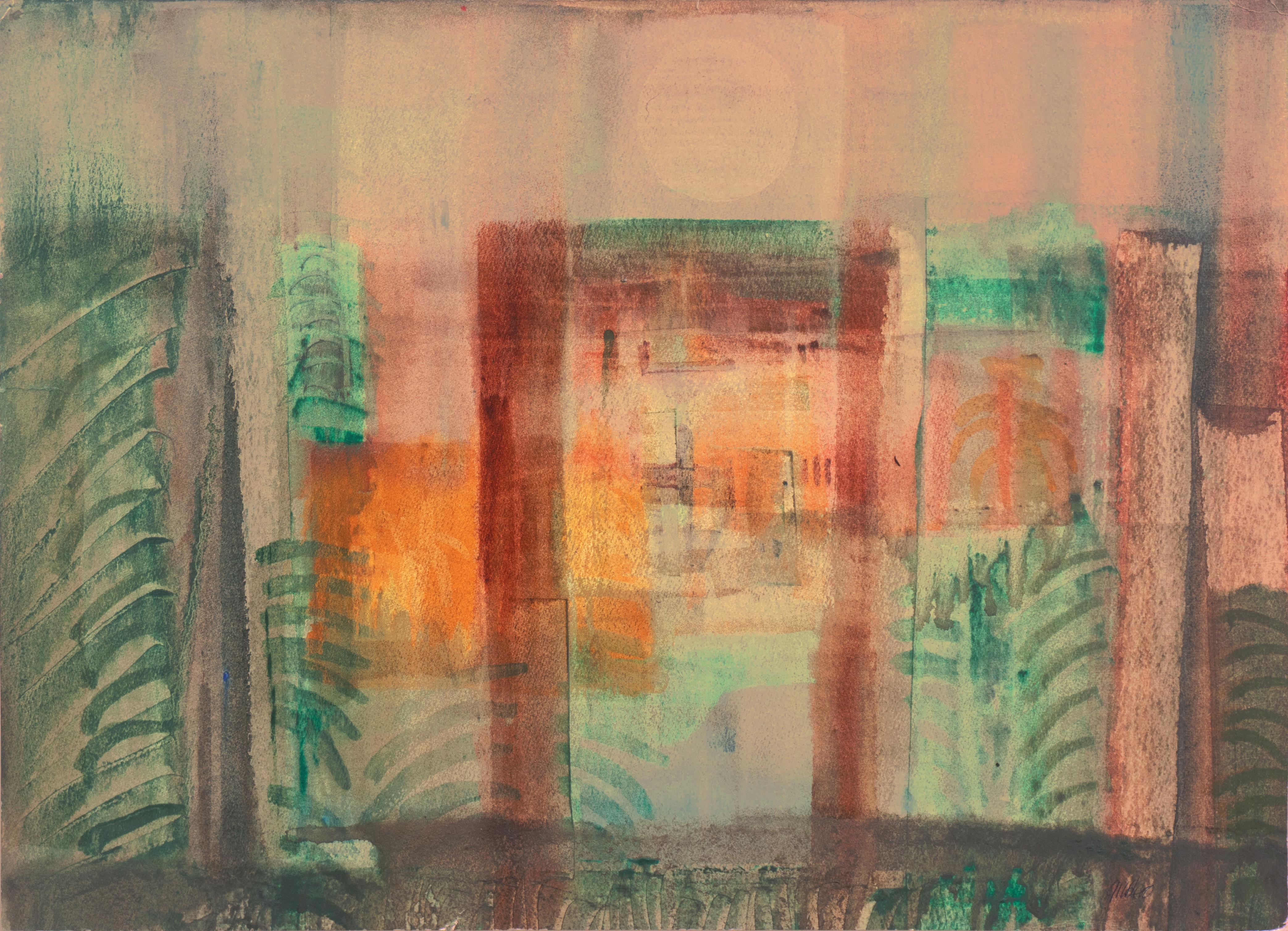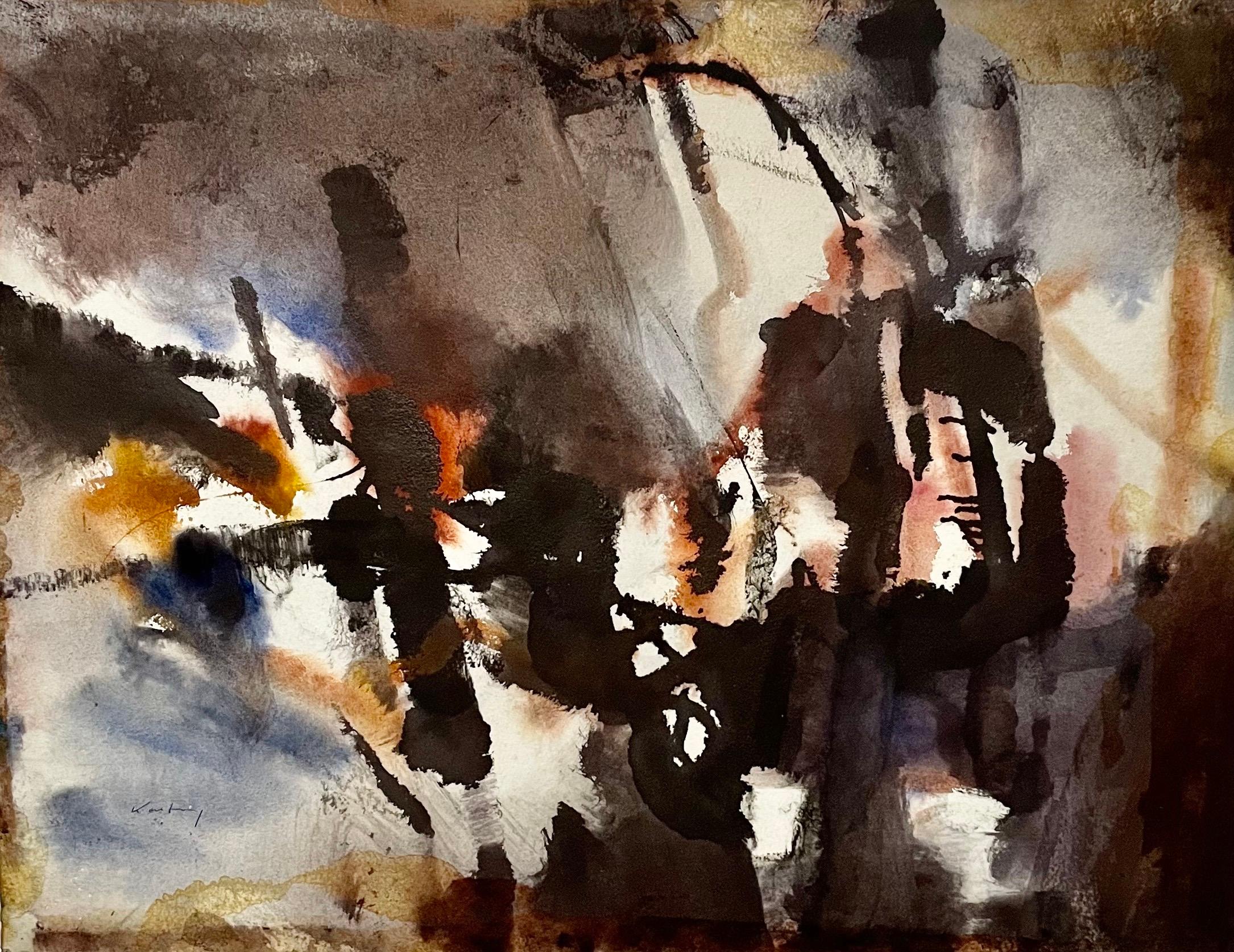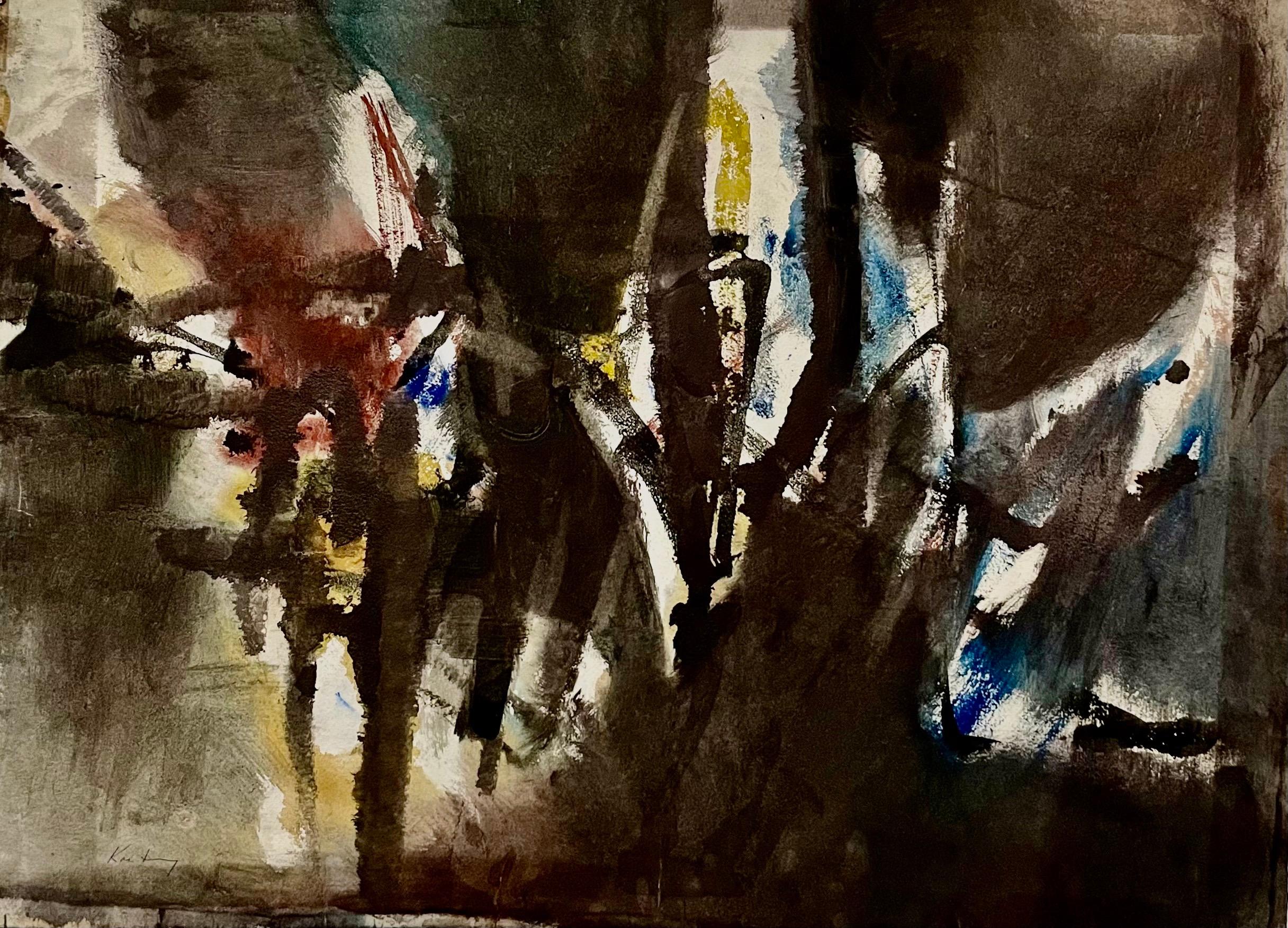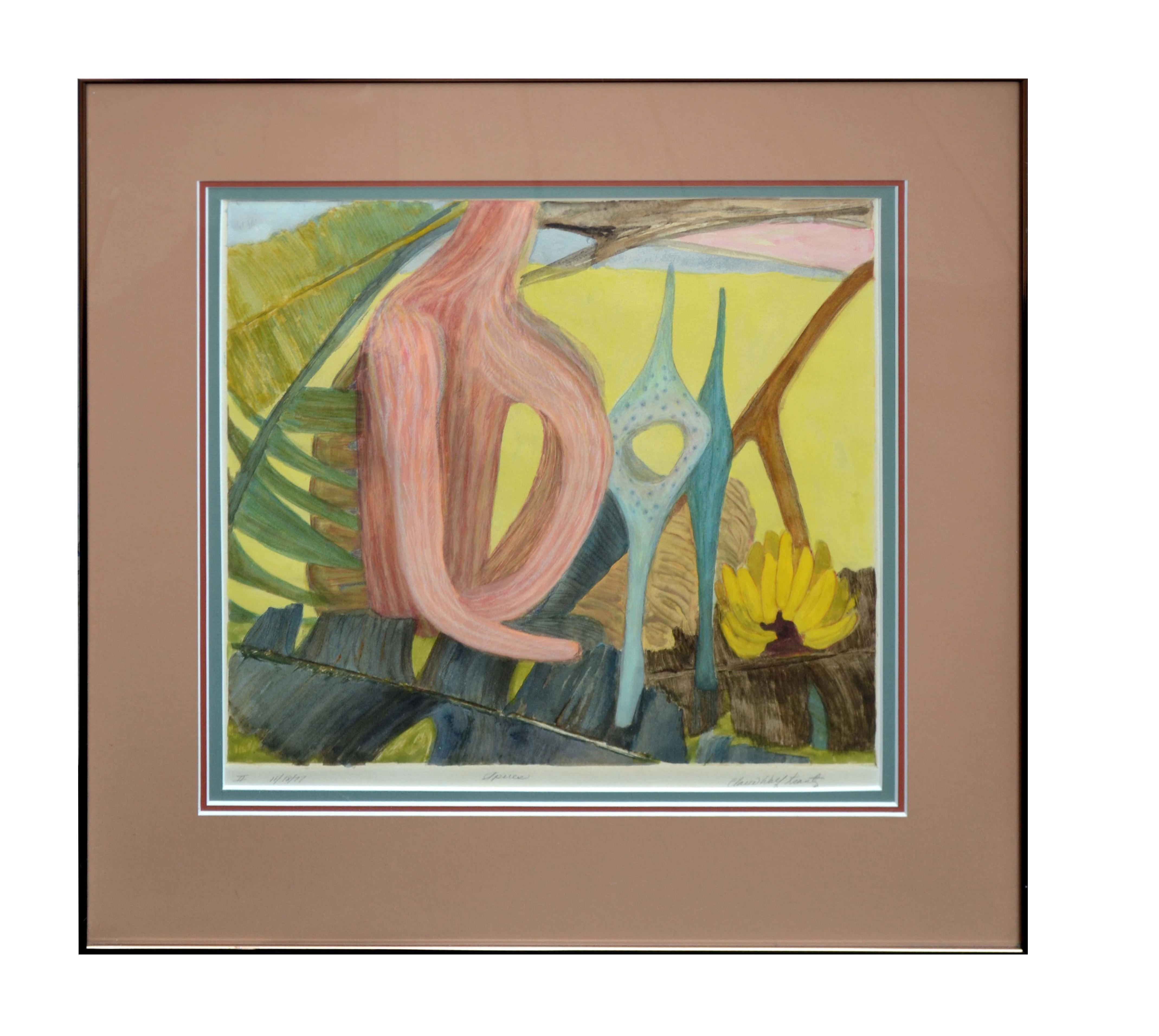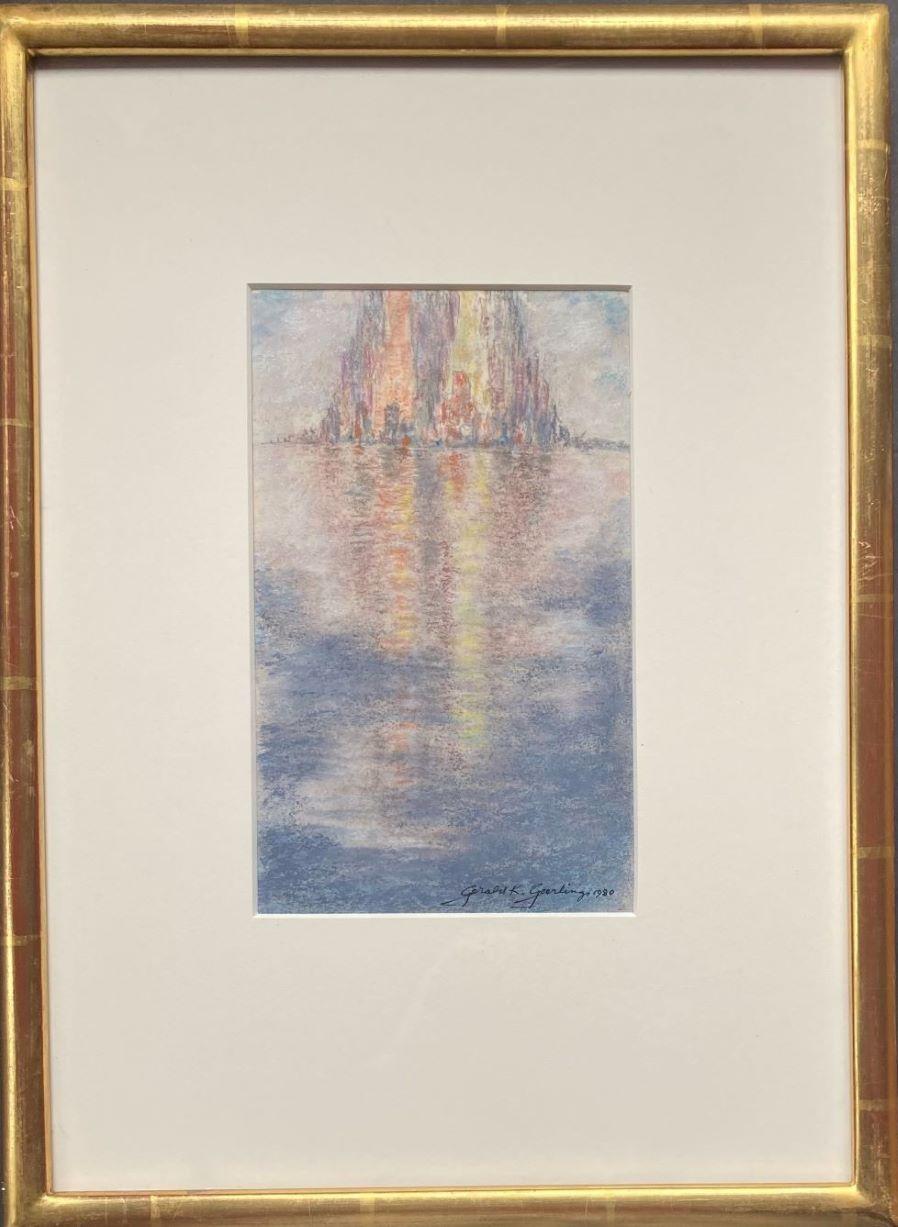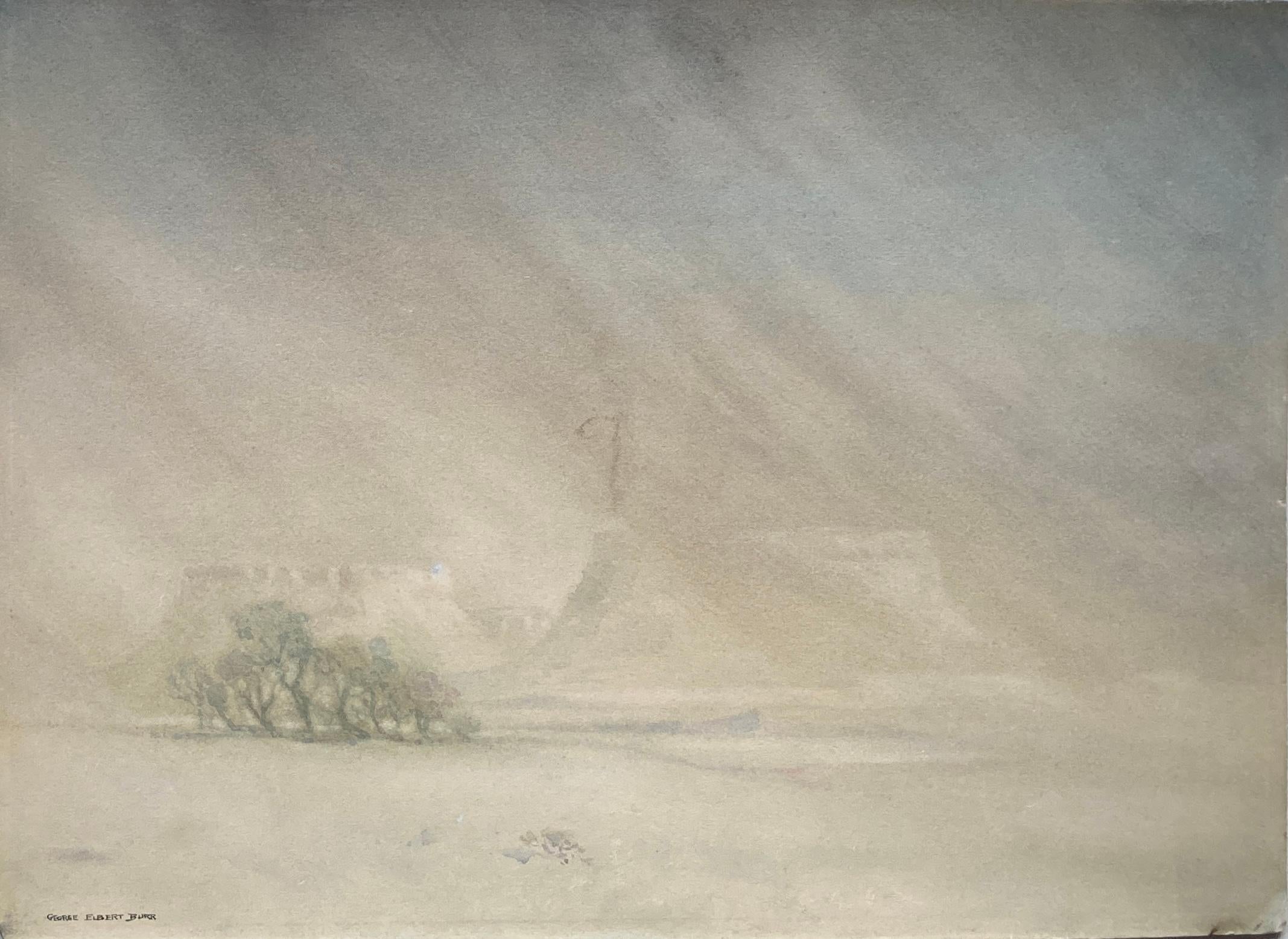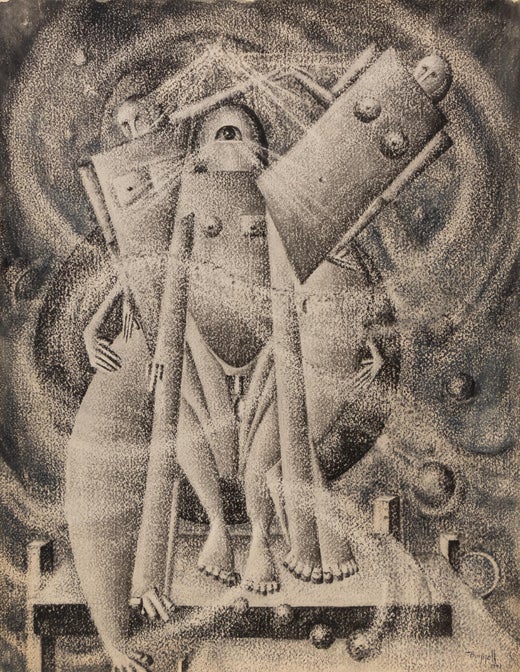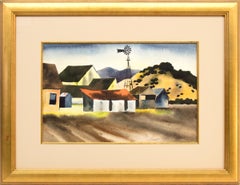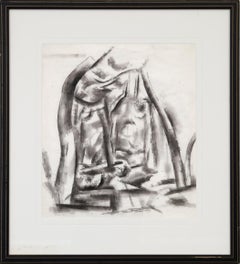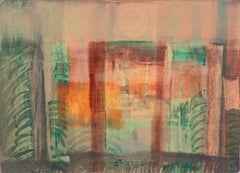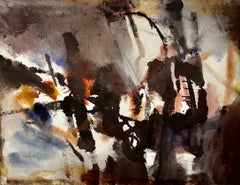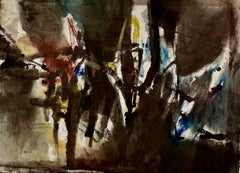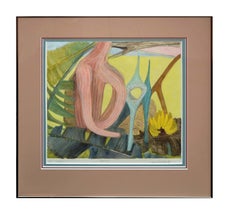Items Similar to Georgetown, Colorado, 1938 WPA Era Ink Drawing of Rocky Mountain Landscape
Video Loading
Want more images or videos?
Request additional images or videos from the seller
1 of 13
Charles Ragland BunnellGeorgetown, Colorado, 1938 WPA Era Ink Drawing of Rocky Mountain Landscape1938
1938
About the Item
This vintage 1938 ink drawing by Charles Bunnell (1897–1968) captures a stunning scene of a church nestled in the majestic Rocky Mountains of Georgetown, Colorado. Executed in bold black ink on creamy white paper, the piece is signed and dated by the artist in the lower right and titled in the lower left. The image size is 7 ¾ x 5 ¾ inches, and it is framed with archival materials, with outer dimensions measuring 16 ¼ x 14 ½ x 1 ¼ inches.
Condition:
The drawing is in good vintage condition, with no notable flaws. For a detailed condition report, please contact us directly.
Provenance:
This artwork comes from the estate of Charles Ragland Bunnell, ensuring its authenticity.
About Charles Bunnell:
Charles Bunnell was a prominent American artist whose career spanned multiple styles and influences. Born in Kansas City, Missouri, he moved to Colorado Springs around 1915, where he developed a love for art. After serving in World War I, Bunnell studied at the Broadmoor Art Academy (later renamed the Colorado Springs Fine Arts Center), where he met his wife, Laura Palmer. He went on to teach and paint in Colorado, creating works that reflected his diverse artistic journey.
Bunnell was influenced by both realism and abstraction. Although he initially studied under Boardman Robinson, mastering the American Scene style, Bunnell's artistic vision evolved toward abstraction. By the late 1930s, his work began to depart from his early Modernist style, embracing more abstract forms. His experiences during World War II and the personal loss of his son deeply impacted his work, leading him to explore Transcendental and Surrealist themes in the early 1940s.
In the late 1940s, Bunnell was instrumental in introducing Abstract Expressionism to Colorado Springs, despite resistance from the art community. His groundbreaking work continues to be celebrated for its emotional depth, political commentary, and stylistic innovation.
- Creator:Charles Ragland Bunnell (1897-1968, American)
- Creation Year:1938
- Dimensions:Height: 16.25 in (41.28 cm)Width: 14.5 in (36.83 cm)Depth: 1.25 in (3.18 cm)
- Medium:
- Movement & Style:
- Period:
- Framing:Frame IncludedFraming Options Available
- Condition:Very good vintage condition, custom frame with all archival materials has recently been added. Detailed condition report available upon request.
- Gallery Location:Denver, CO
- Reference Number:Seller: DCG-236051stDibs: LU2738037562
Charles Ragland Bunnell
Charles Bunnell developed a love for art at a very young age. As a child in Kansas City, Missouri, he spent much of his time drawing. When he was unable to find paper he drew on walls and in the margins of textbooks for which he was often fined. Around 1915, Bunnell moved with his family to Colorado Springs, Colorado. He served in World War I and later used his GI Training to study at the Broadmoor Art Academy (later renamed the Colorado Springs Fine Arts Center) during 1922 and 1923. In 1922, he married fellow student, Laura Palmer. He studied with Ernest Lawson in 1927-1928 and, in the winter of 1928-1929, he served as Lawson’s assistant. In the late 1920’s, the Bunnell’s settled just west of Colorado Springs and 1928, they welcomed the first of their three children. Their one-acre homesite, which they referred to as “Old Home Place”, was situated between two sets of railroad tracks at the foot of Pike’s Peak. Charlie converted an old railroad boxcar into his studio, where he later gave lessons. Beginning in 1931, Bunnell spent a year and a half studying under Boardman Robinson. The two men clashed constantly due to a generation gap and markedly different philosophies. Robinson encouraged his students not to stray from realism and though Bunnell mastered Robinson’s preferred style of American Scene painting, he regularly irritated his professor with his abstract sketches. Bunnell taught at the Kansas City Art Institute during the summers of 1929, 1930, 1940, and 1941. Between 1934 and 1941, he painted and taught under federal projects which included assisting Frank Mechau on murals for the Colorado Springs Post Office. However, he did not take to mural making and, after criticism from Boardman Robinson about his use of “heavy daubs which have no place in mural work,” he abandoned mural-making altogether. By the late 1930’s, Bunnell’s work departed from the American Scene/Modernist style he was trained in towards abstraction. This is marked by his “Black and Blue” series, consisting of 83 abstracted ink and watercolors. Affected by the Second World War and the loss of his 10-year old son, Bunnell’s work of the early 1940’s took on a Transcendental and Surrealist tone. The works from this period are moody and readily reflect the political and personal turmoil experienced by the artist. In the late 1940’s, Bunnell began experimenting with Abstract Expressionism. He alone is credited with introducing Colorado Springs to the new style as it was excluded from the Fine Art Center’s curriculum by Boardman Robinson. Bunnell excelled in Abstract Expressionism and continued to evolve in the style through the 1950’s continuing to his death in 1968. He was recently recognized as a premier American Abstract Expressionist by his inclusion in the book American Abstract Expressionism of the 1950’s: An Illustrated Survey. © David Cook Galleries, LLC
About the Seller
5.0
Vetted Professional Seller
Every seller passes strict standards for authenticity and reliability
Established in 1979
1stDibs seller since 2013
286 sales on 1stDibs
Typical response time: <1 hour
- ShippingRetrieving quote...Shipping from: Denver, CO
- Return Policy
Authenticity Guarantee
In the unlikely event there’s an issue with an item’s authenticity, contact us within 1 year for a full refund. DetailsMoney-Back Guarantee
If your item is not as described, is damaged in transit, or does not arrive, contact us within 7 days for a full refund. Details24-Hour Cancellation
You have a 24-hour grace period in which to reconsider your purchase, with no questions asked.Vetted Professional Sellers
Our world-class sellers must adhere to strict standards for service and quality, maintaining the integrity of our listings.Price-Match Guarantee
If you find that a seller listed the same item for a lower price elsewhere, we’ll match it.Trusted Global Delivery
Our best-in-class carrier network provides specialized shipping options worldwide, including custom delivery.More From This Seller
View All1930s American Modern Farm Landscape Watercolor with Barns, Windmill & Fields
By Samuel Bolton Colburn
Located in Denver, CO
This original watercolor painting by acclaimed American artist Samuel Bolton Colburn captures a quiet farmstead nestled in a mountain valley. Rendered with Colburn’s signature contro...
Category
1930s American Modern Landscape Drawings and Watercolors
Materials
Watercolor
The Cliff, Abstract Colorado Landscape, 1940s American Modernist Pastel Drawing
By Eric Bransby
Located in Denver, CO
This stunning artwork features an expressive blend of vibrant green, orange, blue, and purple tones, capturing the dynamic beauty of Colorado’s mountainous terrain. Created by renown...
Category
1990s Abstract Abstract Drawings and Watercolors
Materials
Oil Pastel, Pastel, Archival Paper
Early 20th Century Black & White Abstract Landscape Charcoal Drawing Artwork
By Willard Ayer Nash
Located in Denver, CO
"Abstract" is an original charcoal drawing on paper American artist Willard Ayers Nash (1898-1942), created in the early 20th century. This striking piece features an abstracted landscape scene, showcasing Nash's mastery of form and dynamic expression. The drawing is presented in a custom black frame with outer dimensions of 22 x 20 x ¾ inches, and the image size is 14 ½ x 12 ¾ inches.
This charcoal drawing is in excellent vintage condition. For a detailed condition report, please feel free to contact us.
Expedited and international shipping available—please contact us for a shipping quote.
About the Artist:
Willard Ayers Nash (1898-1942), born in Philadelphia, Pennsylvania, was a talented American painter and key figure in the Santa Fe...
Category
Early 20th Century Abstract Abstract Drawings and Watercolors
Materials
Paper, Charcoal
$3,800 Sale Price
20% Off
Hopi Village on First Mesa, Arizona: Red, Blue, Orange Mixed Media Landscape Art
Located in Denver, CO
This striking mixed-media artwork, titled Walpi #9 (Hopi Village on First Mesa, Arizona), is a masterful combination of watercolor, ink, and charcoal on paper by Bert Van Bork...
Category
1990s American Modern Landscape Drawings and Watercolors
Materials
Charcoal, Ink, Watercolor
Second Mesa Hopi Pueblo Arizona Multicolored Southwest Mixed Media Landscape Art
Located in Denver, CO
"Second Mesa (Hopi Pueblo, Arizona)" is a stunning mixed media artwork by Bert Van Bork (1928-2014), created using watercolor, ink, and charcoal on paper...
Category
1980s American Modern Landscape Drawings and Watercolors
Materials
Charcoal, Archival Ink, Watercolor
Windmill on the Plains, 1940s Watercolor & Ink Mixed Media Modernist Landscape
By Jenne Magafan
Located in Denver, CO
"Windmill on the Plains" is a captivating watercolor and ink on paper painting by 20th century Colorado artist Jenne Magafan. Created in the 1940s, this work depicts a large windmill...
Category
1940s American Modern Landscape Drawings and Watercolors
Materials
Paper, Ink, Watercolor
You May Also Like
'Evening Landscape' Bay Area Abstraction, San Francisco Museum of Fine Arts, CWS
By Robert George Gilberg
Located in Santa Cruz, CA
Signed lower right, 'Gilberg' for Robert George Gilberg (American, 1911-1970) and painted circa 1965.
Born in Oakland, Robert George Gilberg first studied at the Oakland Art Center during the 1930s. Following service during WWII, he settled in Nevada City, California where he lived and painted until shortly before his death in San Francisco. Gilberg exhibited widely and with success and was the recipient of numerous medals, prizes and juried awards, including at the San Francisco Museum of Fine Arts...
Category
1960s American Modern Landscape Drawings and Watercolors
Materials
Paper, Ink, Watercolor
Modernist Abstract Expressionist Watercolor Painting Bauhaus Weimar Pawel Kontny
By Pawel Kontny
Located in Surfside, FL
Abstract watercolor composition bearing the influence of the earlier color-block compositions of Paul Klee.
Pawel August Kontny, (Polish-German-American artist) He was born in Laurahuette, Poland, in 1923, the son of a wealthy pastry shop owner. In 1939 he began studying architecture in Breslau where he was introduced to the European masters and to the work of some of the German Expressionists, soon afterward banned as "degenerate artists" and removed from museums throughout Germany by the Nazi regime. His studies were interrupted by World War II. Drafted into the German army, traveling in many countries as a soldier, he sketched various landscapes but in 1945, he was captured and held as a prisoner of war in Italy. After the war, he studied at the Union of Nuremberg Architects to help design buildings to replace ones destroyed in the war. He recorded his impressions of the local population and the landscapes through his watercolors and drawings. Pawel Kontny thereafter moved to Nuremberg, Germany, becoming a member of the Union of Nuremberg Architects and helping to rebuild the city's historic center. He soon decided to concentrate on his professional art career. He married Irmgard Laurer, a dancer with the Nuremberg Opera. Pavel Kontny 's career as an artist was launched with his participation in an all German exhibition, held at the Dusseldorf Museum in 1952. He held one-man shows in Germany, Switzerland and the United States. During his trip to the United States in 1960, Kontny became instantly enamored with Colorado, and decided to relocate to Cherry Hills with his wife and two children. He quickly established himself in the local art community, being affiliated for a time with Denver Art Galleries and Saks Galleries. His subject matter became the Southwest. During this time he received the Prestigious Gold Medal of the Art Academy of Rome. His extensive travel provided material for the paintings he did using his hallmark marble dust technique. he also worked equally in pastel, watercolor, charcoal and pencil-and-ink. in a style which merged abstraction and realist styles, influenced by Abstract Expressionist painting and South Western American landscapes. This one bears the influence of Sam Francis. In the early 1960s he was one of only a few European-born professional artists in the state, a select group that included Herbert Bayer (1900-1985), a member of the prewar Bauhaus in Weimar and Dessau, Germany, and Roland Detre (1903-2001), a Hungarian modernist painter. As a Denver, Colorado resident, Pavel Kontny exhibited at galleries and museums throughout the United States, Germany and Japan. There, he was inspired by frequent trips to Native American pueblos in the Southwest, as well as by the study of the Plains Indians of Montana and Wyoming. Over the years Kontny had a number of students and generously helped young artist by hosting exhibitions at his Cherry Hills home. For many years he generously donated his paintings to support charitable causes in Denver. Influences during his European years included German pastelist C.O. Muller, German Informel painter Karl Dahmen and Swiss artist, Hans Erni. In the early 1950s his painting style showed the influence of the Die Brücke (The Bridge), a group of German expressionist artists formed in Dresden in 1905 who had a major impact on the evolution of modern art in the twentieth century in Germany. By the middle of the decade his style incorporated more referential abstraction and total abstraction, resulting in part from his study of Hans Hartung, a German artist based in Paris who exhibited his gestural abstract work in Germany. The American moon landing in 1969 inspired Paul Kontny...
Category
20th Century American Modern Abstract Drawings and Watercolors
Materials
Watercolor, Archival Paper
Modernist Abstract Expressionist Watercolor Painting Bauhaus Weimar Pawel Kontny
By Pawel Kontny
Located in Surfside, FL
Abstract watercolor composition bearing the influence of the earlier color-block compositions of Paul Klee.
Pawel August Kontny, (Polish-German-American artist) He was born in Laurahuette, Poland, in 1923, the son of a wealthy pastry shop owner. In 1939 he began studying architecture in Breslau where he was introduced to the European masters and to the work of some of the German Expressionists, soon afterward banned as "degenerate artists" and removed from museums throughout Germany by the Nazi regime. His studies were interrupted by World War II. Drafted into the German army, traveling in many countries as a soldier, he sketched various landscapes but in 1945, he was captured and held as a prisoner of war in Italy. After the war, he studied at the Union of Nuremberg Architects to help design buildings to replace ones destroyed in the war. He recorded his impressions of the local population and the landscapes through his watercolors and drawings. Pawel Kontny thereafter moved to Nuremberg, Germany, becoming a member of the Union of Nuremberg Architects and helping to rebuild the city's historic center. He soon decided to concentrate on his professional art career. He married Irmgard Laurer, a dancer with the Nuremberg Opera. Pavel Kontny 's career as an artist was launched with his participation in an all German exhibition, held at the Dusseldorf Museum in 1952. He held one-man shows in Germany, Switzerland and the United States. During his trip to the United States in 1960, Kontny became instantly enamored with Colorado, and decided to relocate to Cherry Hills with his wife and two children. He quickly established himself in the local art community, being affiliated for a time with Denver Art Galleries and Saks Galleries. His subject matter became the Southwest. During this time he received the Prestigious Gold Medal of the Art Academy of Rome. His extensive travel provided material for the paintings he did using his hallmark marble dust technique. he also worked equally in pastel, watercolor, charcoal and pencil-and-ink. in a style which merged abstraction and realist styles, influenced by Abstract Expressionist painting and South Western American landscapes. This one bears the influence of Sam Francis. In the early 1960s he was one of only a few European-born professional artists in the state, a select group that included Herbert Bayer (1900-1985), a member of the prewar Bauhaus in Weimar and Dessau, Germany, and Roland Detre (1903-2001), a Hungarian modernist painter. As a Denver, Colorado resident, Pavel Kontny exhibited at galleries and museums throughout the United States, Germany and Japan. There, he was inspired by frequent trips to Native American pueblos in the Southwest, as well as by the study of the Plains Indians of Montana and Wyoming. Over the years Kontny had a number of students and generously helped young artist by hosting exhibitions at his Cherry Hills home. For many years he generously donated his paintings to support charitable causes in Denver. Influences during his European years included German pastelist C.O. Muller, German Informel painter Karl Dahmen and Swiss artist, Hans Erni. In the early 1950s his painting style showed the influence of the Die Brücke (The Bridge), a group of German expressionist artists formed in Dresden in 1905 who had a major impact on the evolution of modern art in the twentieth century in Germany. By the middle of the decade his style incorporated more referential abstraction and total abstraction, resulting in part from his study of Hans Hartung, a German artist based in Paris who exhibited his gestural abstract work in Germany. The American moon landing in 1969 inspired Paul Kontny...
Category
20th Century American Modern Abstract Drawings and Watercolors
Materials
Watercolor, Archival Paper
Modern Tropical Abstract -- "Spires II"
Located in Soquel, CA
Colorful abstract watercolor of imaginative shapes in a tropical setting with botanical landscape elements by Claire Wolf Krantz (American, b. 1938). Signed "Claire Wolf Krantz" lower right. Titled "Spires" lower center. Dated "11/18/77" and numbered "II" in a series lower left. Peach colored mat and bronze tone metal frame. Image, 14"H x 14"L.
Kranz is an artist and art critic living in Chicago, she uses fictional and real elements in her works. She is known for mixed media works layering photograph...
Category
1970s American Modern Abstract Drawings and Watercolors
Materials
Paper, Watercolor
$476 Sale Price
20% Off
Cityscape Reflections - Study No. 1
By Gerald Geerlings
Located in Storrs, CT
Cityscape Reflections - Misty Morning. 1980. Lithograph with pastel coloring. Czestochowski 42. Edition 40. 14 x 10 3/16 (sheet 18 x 14). Tape stains in the margins, not affecting th...
Category
Late 20th Century American Modern Landscape Drawings and Watercolors
Materials
Pastel
A Sandstorm on the Little Colorado River, Arizona
By George Elbert Burr
Located in Storrs, CT
A Sandstorm on the Little Colorado River, Arizona. 1920. Watercolor on watercolor board. Study for Seeber 189. 10 3/8 x 14 1/4. Signed lower left; titled verso. An exquisitely subtl...
Category
Early 20th Century American Modern Landscape Drawings and Watercolors
Materials
Watercolor
$1,800 Sale Price
20% Off
Recently Viewed
View AllMore Ways To Browse
Black And White Landscape Drawings
Colorado Mountain Art
Vintage Rockies
Rocky Mountain Paintings
Colorado Mountains Painting
Wpa Style
Wpa Style Painting
Artist Painting Landscape Wpa
Colorado Rockies Art
Charles Church
Surrealist Drawing Black And White
Georgetown Painting
Wpa Era Paintings
Colorado Mountain Watercolor
American Realism Wpa
Wpa Art Charles
Georgetown Frame
Wpa Era Landscapes
